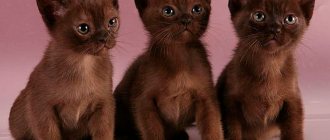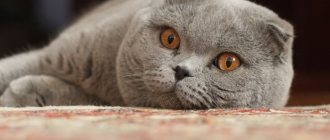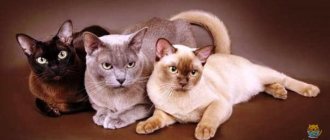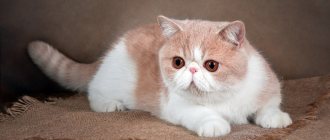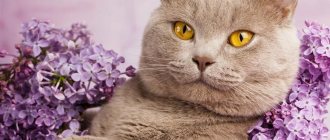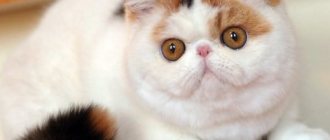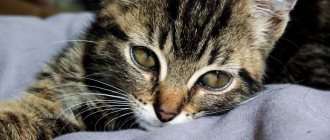Description of the Burmese cat breed
The description of the above breed includes several characteristics and qualities that the animal must fully comply with.
Dimensions and weight of the Burmese cat
When you look at a Burmese cat, you get the impression that it is a very light, almost weightless, medium-sized animal. But as soon as you take her in your arms, you immediately understand your mistake. So, an adult cat of this breed can weigh about 9 kilograms, and a female cat can weigh about 6 kilograms. It’s not for nothing that the popular phrase “a brick wrapped in silk” is used to describe the Burmese breed.
If we consider the weight of the Burmese by month, we get the following picture:
| Age | Male | Female |
| 1 month | From 450 to 750 grams | From 300 to 500 grams |
| 3 months | From 1.5 to 2.4 kg | From 1.2 to 1.7 kg |
| 6 months | From 3 to 5.7 kg | From 2.5 to 3.6 kg |
| 1 year | From 6 to 7.5 kg | From 3.5 to 5.4 kg |
| 2 years | From 8 to 9 kg | From 4 to 6 kg |
Burmese standard
- Build: Muscular, strong, incredibly well-built, medium size. Males are always larger and heavier than females. The chest is quite powerful, which gives the impression of the strength of the Burmese cat. The back is equal.
- Coat: thick, short, without undercoat, very soft and pleasant to the touch, dense.
- Head: rounded, muzzle short with an elongated forehead, wide cheekbones.
- Neck: strong, thin and long.
- Eyes: large, very expressive, round in shape. They shimmer in all shades of yellow (from honey to amber) and green. Moreover, the older the Burmese cat is, the lighter the color of its eyes becomes.
- Ears: beautiful triangular shape, slightly rounded tips.
- Limbs: ideally proportional to the body, medium size. The paws are neat with fairly developed muscles. This cat breed has five toes on the forelimbs and four on the hind limbs.
- Tail: Medium length, slightly tapering towards the tip.
Colors of Burmese cats
The color of Burmese cats also has its own characteristics. Thus, the European type of this breed is allowed to have almost any color without stripes or spots. But the American type is allowed to have only four colors:
- Sable. It is a rich chocolate shade that becomes darker on the face, paws and tail.
- Blue. This color can be either uniform or slightly darkened on the tail and muzzle.
- Champagne. Its color is a little reminiscent of coffee with milk, but it becomes darker on the paws, nose, tail, and ears.
- Platinum. It is also called lilac. It's a beautiful shade of creamy color that deepens on the face.
The difference between the American Burmese and the European
Today there are two types of Burmese breed: American and European.
The European Burmese are distinguished by greater “refinement”. It has less weight and a more elongated body. The muscles are noticeably weaker. But the limbs are longer and slimmer. The eyes can be described as almond-shaped, which gives cats a stern look.
The American Burmese cat is heavier. It has a round head and muzzle, and the eyes are also round, which gives them a good-natured and even somewhat naive look. In addition, the ears of this type are slightly rounded.
Tips for choosing
First of all, you should approach the place where you purchase a kitten responsibly. If possible, you should avoid buying a Burmese cat at a local pet market, because such establishments most often do not sell purebred pedigreed cats.
Find experienced breeders or a special nursery in your city. The room should be moderately spacious, bright, always clean and well-groomed. The sections where the kittens are kept must also look decent without violating the rules for keeping animals.
When assessing the kitten itself, attention should be paid to:
- behavior (plays, is active, interacts with people and other kittens, shows curiosity);
- appearance (clean ears, shiny fur, eyes without purulent discharge, teeth and claws in order);
Character and habits
The Burmese cat is an ideal choice for those who are looking for a kind, affectionate, cheerful and loyal animal. The Burmese is incredibly active; even older cats of this breed take great pleasure in chasing sunbeams and flies.
Representatives of the Burmese are often called “cats with the soul of a dog.” Because they simply love to spend time with their owner, to participate in every moment of his life. Therefore, do not be surprised that it will be difficult to drive such a cat off your lap; it will follow you everywhere, and at night it will crawl under the blanket to sleep closer to the person.
An interesting feature: Burmese cats love all family members absolutely equally, but cats choose only one, who will become her favorite. Also, representatives of this breed very sensitively sense the mood of the owner and adapt well to it.
Compatible with children and other pets
Burmese cats get along well and get along well with other animals, be it dogs or parrots.
They also have wonderful relationships with children. Adults can rest assured that representatives of this breed will not scratch or hiss at children; on the contrary, they will happily take part in their games.
Health
This breed of cat has strong immunity, so it is characterized by good health. She has no traces of severe hereditary illnesses. Common diseases include gingivitis. This disease manifests itself in inflammation of the gums and the formation of plaque on the teeth. For preventive purposes, it is worth brushing your pet's teeth regularly.
Sometimes Burmese have difficulty breathing and watery eyes. To prevent this disease, the cat's nose needs to be checked and cleaned. Special eye drops will help reduce your pet's lacrimation. The animal's pregnancy period passes without complications. However, the process of giving birth to kittens can be difficult, so a veterinarian should be present during the birth.
The Burmese cat is considered a real miracle of the animal world. She is quite pretty, graceful, and friendly. Such a cat can become a playful and active member of the family, as well as a friend for children.
You will learn more about the Burmese cat in the following video.
Care and maintenance
Caring for Burmese cats is quite simple, but it requires regularity and time from the owner. To begin with, you need to buy your little pet a cozy bed, toys and a good scratching post.
What to feed the Burmese
Special attention should be paid to feeding the Burmese cat. So, it is better to purchase premium dry food. They contain those minerals and vitamins that allow the Burmese to maintain its majestic appearance, and its coat to shine and shimmer in the sun. In addition, feeding representatives of this breed the same thing will also not work. Dry food needs to be diluted with other food. For example, lean chicken, turkey, veal or rabbit. You can give your Burmese cat vegetables and ready-made cereals, once a week - an egg, boiled sea fish, fermented milk products (low-fat).
Please note that a small kitten (up to five months) should be fed four times a day, a slightly older kitten (up to eight months) should be fed three times, and a completely adult cat should be fed twice a day so that your pet does not gain excess weight .
Wool
Despite the fact that the Burmese cat's fur is not long, it needs to be carefully looked after. So, once a week you need to comb it with a special rubber brush; if your pet sheds, then you should comb it twice. If you want to give Burmese wool a special shine and shine, you can rub it with silk.
You can bathe a Burmese cat no more than once every five months.
Caring for ears, eyes and other body parts
Due to the fact that Burmese cats have a special structure of tear ducts, it is important to wipe your pet’s eyes, and in some cases it is better to use hygienic veterinary drops for this. It is better to clean your ears with a special lotion. Burmese cats also need to be vaccinated regularly. Trim nails once or twice a month.
Walking your pet
The Burmese cat has a fairly calm disposition, so you can either keep it in an apartment or let it go outside. But in any case, it is better to walk the animal under control. For these purposes, it would be good to purchase a leash.
How to choose the right kitten
To be sure that the animal is purebred, it is recommended to buy it from a specialized nursery or from a reliable breeder. Before making a transaction, it is advisable to make sure that the Burmese kitten has documents confirming its breed and vaccinations.
It is also advisable to observe children in their familiar environment. This will help to partially identify the main features of their character and form at least a superficial idea of their state of health.
Burmese kittens should be playful, active and moderately curious. Their appearance must meet the official standard. And there should be no white spots on the fur.
On a note. Burmese kittens are allowed to have faint stripes, which disappear by the age of six months.
Kitten care
Conscientious breeders separate offspring from their mother no earlier than three months of age. Thanks to this, Burmese cats reach their new owners fully vaccinated and quite independent.
These babies can use the litter box without any problems, know how to use a scratching post, and can eat many foods. Therefore, new owners will not have to teach them basic things. You just need to give him time to get used to the changed conditions and show him where the bowls, toilet and place to sleep are located.
To prevent the Burmese kitten from becoming a victim of its own curiosity, wires, household chemicals, indoor plants and fragile objects are hidden from it. Also, for safety reasons, before turning on the washing machine or oven, be sure to check if there is a small pet inside.
To prevent the Burmese from developing digestive problems due to the stress of the move, at first she is fed what the breeder recommended. New foods are introduced into the diet of a kitten of this breed in stages to monitor the body’s reaction.
The feeding schedule is based on the age of the Burmese:
- 3-4 months – 5 times a day;
- 4-7 months – 4 times a day;
- 8-11 months – 3 times a day.
A one-year-old Burmese cat can get by with two feedings a day.
Breeding Burmese cats
The first mating of Burmese cats is best done at two years of age (although the first heat occurs as early as six months). It will be good if the female lives in the male’s territory for several days. A cat's pregnancy lasts 72 days, during which time she becomes especially affectionate and calm. It is also necessary to agree in advance with the specialist who will attend the birth. Kittens are usually born strong and healthy.
Kolenie
The basic nutrition of a Burmese cat is the same as that of all felines and differs at different periods of life (kitten, adult cat, sterilization or castration, pregnancy and the postpartum period).
Decide what food you want to use and do not mix them: will it be natural products or specialized food. Among industrial feeds, give preference to high-quality feeds with a high protein content (see instructions). A natural diet should consist of 80% lean meat, as well as cereals, vegetables and herbs.
For the health of Burmese pets, do not feed them your own food from the table. Cats are prohibited from giving salted, peppered, smoked, etc. products.
History of the Burmese cat breed
The ancient state of Burma (today it is called Myanmar) in Southeast Asia is considered to be the birthplace of Burmese cats. The first mention of these animals was found in manuscripts of the 12th century, and medieval books even contain their images.
It is believed that Burmese cats lived at temples, and accordingly, they were equated with sacred animals. The monks took care and patronage of them in every possible way, thus demonstrating their respect and veneration for the gods. It was the Burmese cats that accompanied the deceased to the afterlife, protecting his peace. Also, according to legend, it was these animals that brought wealth and good luck to their owner, so royal and aristocratic families tried to get themselves a Burmese cat. Foreigners could receive them only as a gift for great devotion. At that time, the animal had a beautiful sable color.
It was only in the 19th century that Burmese cats first came to Britain, known as Black Siamese. Modern Burmese owe their appearance to the doctor Joseph Thompson, who in 1920 brought a small kitten named Wong Meow to America and began crossing him with Siamese. As a result, back in 1938, a breed with an incredible chocolate color appeared. In the same year, she was presented to the attention of felinologists and registered. After World War II, the Burmese breed was developed with an amazing tortoiseshell and cream coloration. And then cats of this breed spread throughout the world.
Purchase: recommendations
Burmese kittens must be four months old at the time of purchase.
This way you can protect yourself as much as possible from purchasing a sick pet with genetic abnormalities, which will definitely manifest themselves at this age.
Burmese kittens
The kitten must have a color that meets the standard without white spots. The paws should be straight and strong, the eyes should be clear, the tail should not be kinked or damaged, and the belly should not be swollen.
The purchased animal must be active and easy to contact. You can try playing with it.
It is better to think in advance what gender and color you would like to get a pet. You should also immediately decide on the purpose of acquisition - for exhibition activities and breeding (show class) or just for yourself (pet class and below).
Where to buy, what to look for
Burmese are popular in Russia; many nurseries breed them. Basically, the sale of Burmese kittens is carried out by prior arrangement.
You should choose a nursery in advance. You can contact the club for recommendations on thematic forums.
On the page of the nursery’s website you can study the pedigrees of the parents, trace the offspring of the couple’s previous litters, and see how well they are exhibited.
Burmese are popular in Russia, many nurseries breed them
Burmese cat price
The price of purchasing a Burmese kitten depends on:
- titles and quality of ancestors' pedigrees;
- color,
- age of the animal;
- class;
- presence of deviations from breed standards;
- gender
The price of a show-class kitten is 80-100 thousand rubles in the Moscow experimental nursery from producers raised and purchased abroad.
Pet class kittens can be purchased for up to 40,000 rubles. Breeding class kittens can cost up to 25,000 rubles.
